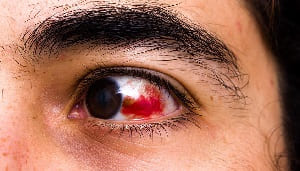Home › Scuba Diving A-Z › Injuries › Face Squeeze
Mask Squeeze Diving Injury
A common mistake made by new scuba divers and freedivers is failing to equalise the pressure in the dive mask as they break the surface and descend.
This guide explains what face mask squeeze injuries look like, the symptoms, treatment, and tips for beginners for preventing facial barotrauma.
Why Do New Divers Get Face Mask Squeeze
When you start scuba diving (or learn how to freedive) equalisation will be an important skill to master.
Here's why:
As you descend, the pressure inside the face mask should be the same as the water pressure that surrounds it.
So, knowing how to equalise air spaces (e.g. ears, mask, sinuses) will help you avoid painful injuries.
Pro Tip: Inexperience is a primary risk factor for mask squeeze injury.
Several things can happen if a negative pressure exists between the air space inside the mask and the surrounding water pressure.
It can injure blood vessels and nasal tissues, especially in the periorbital region (an area covered by the orbicularis oculi (OOc) m), and the lower forehead.
Common Causes of Facial Barotrauma
In fact, most of the serious injuries associated with scuba do not include this 'relatively' benign condition. Even so, it is best to avoid using scuba masks that have a high internal volume.
Other contributing factors include nasal congestion, wearing a nose clip, recent eye surgery, and pre existing cases of glaucoma.
In addition, using snorkeling masks or swim masks (goggles) that do not cover the nose will exacerbate this type of injury. This is because the simple method used by divers to equalise a dive mask is to exhale air gently through the nose to balance the pressures.
In general, a diver who is experiencing any kind of suction on the face should ascend a little closer to the surface to reduce the pressure and add more air.
Signs and Symptoms of Mask Squeeze
There are several complications associated with a face squeeze. But, even though it looks a lot more painful than it usually is, the condition is not permanent.
Divers who fail to equalise early and often will experience a feeling of 'suction' over their cheeks, eyelids, eyeballs, and nose. This happens because the pressure on the outside of the mask is increasing (e.g. during a descent). The typical signs and symptoms can include:
- A feeling of facial pressure
 Blood spots in the sclera (whites of the eyes)
Blood spots in the sclera (whites of the eyes)- Bruising around the eyes
- Facial bruising and swelling
- Haemorrhage
- Mild discomfort
- Nosebleed
- Pain (if the mask squeezes into the face)
- Skin redness around the eyes and face
- Subconjunctival petechiae (purple spots)
- Vision disturbances (not common)
Treatment for Facial Barotrauma
The healing process for mild or minor symptoms corresponds with the circulatory system. As bruised blood heals, you will see it change from the initial bright red colouring to a dark purple red.
As a result, you may also see the white of your eyes have a yellowish tinge to them, before they finally return to normal in a few weeks as the body reabsorbs the blood.
But, you will need to see your doctor or an eye specialist if you have any visual disturbances (e.g. blurred vision) or:
- Blurred eyesight
- Eye pain
- Hyphema (accumulation of blood in the anterior chamber of the eye)
- Loss in the normal field of vision
Most of the professional advice about personal eye health suggests using a cold compress to treat any swelling on the cheeks, bridge of the nose, or forehead.
Tips for Preventing Mask Squeeze
- Keep the nasal passageways open as you descend. Blow little puffs of air through your nose into the mask when you equalise your ears.
- Use one of the best dive masks to suit your budget and make sure it fits comfortably around the contours of your face.
- You will have an appropriate seal if you can secure it on your face while leaning forward slightly and inhaling through your nose. If it falls off, you can be sure that you'll have dive mask leakage problems underwater.
Implications for Divers
You can call the Divers Alert Network hotline number to get medical recommendations about mask squeezes. But, assuming the treatment worked, and a physician sees no risk of further injury, you can make a full return to diving again.
Implications for Dive Operators
All dive shops and scuba educators have a duty of care to follow if a student gets injured during any of the diving activites offered. Hence, be sure to offer to have a medical professional evaluate the diver as appropriate.
Related Information and Help Guides
- Can You Go Scuba Diving if You Have Vertigo?
- Health and Safety Rules in Scuba Diving
- How Can Salt Water Aspiration Syndrome Affect a Diver?
- How Many Scuba Divers Die Each Year Worldwide?
- Middle-Ear Barotrauma Symptoms and Treatment
Important: The short tutorial video [4:01 seconds] presented by DAN explains how to avoid having a mask squeeze injury with extra safety tips for new divers.